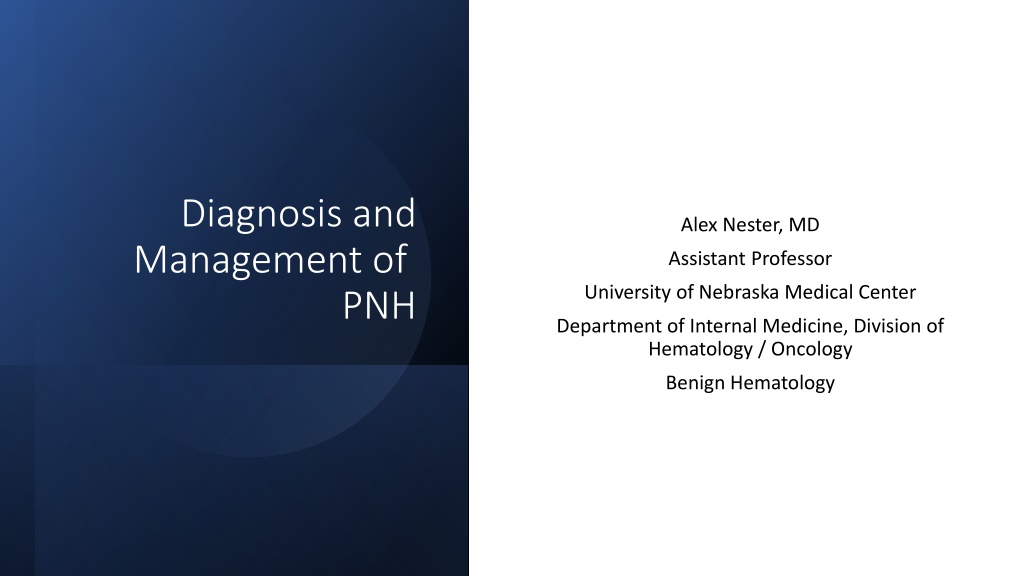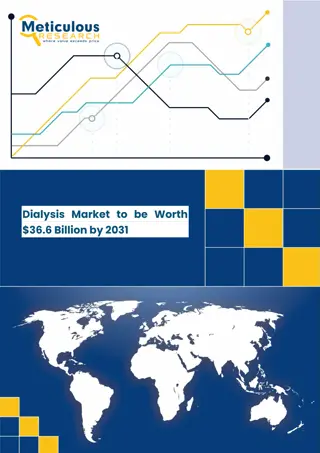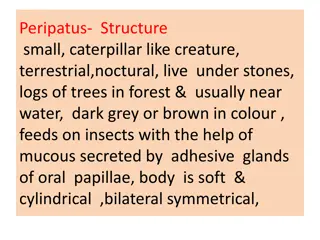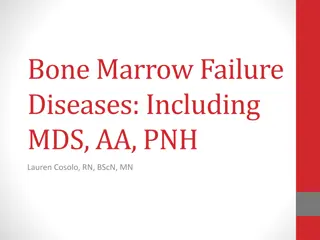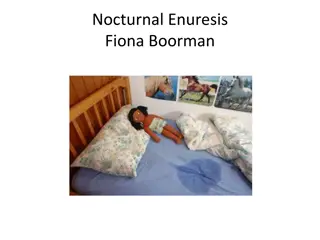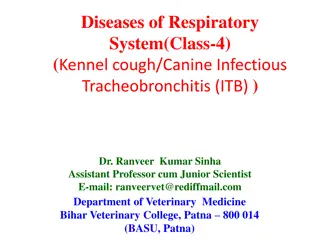Paroxysmal Nocturnal Hemoglobinuria (PNH)
Paroxysmal Nocturnal Hemoglobinuria (PNH) is a rare blood disorder characterized by the destruction of red blood cells in the bloodstream, leading to anemia, hemoglobinuria, jaundice, and other symptoms. It is often challenging to diagnose due to its rarity. PNH can be a thrombophilic state, causing thrombosis as a major cause of mortality in patients. Treatment involves managing hemolysis and complications of thrombosis, with chronic anticoagulation being a common approach.
Download Presentation

Please find below an Image/Link to download the presentation.
The content on the website is provided AS IS for your information and personal use only. It may not be sold, licensed, or shared on other websites without obtaining consent from the author.If you encounter any issues during the download, it is possible that the publisher has removed the file from their server.
You are allowed to download the files provided on this website for personal or commercial use, subject to the condition that they are used lawfully. All files are the property of their respective owners.
The content on the website is provided AS IS for your information and personal use only. It may not be sold, licensed, or shared on other websites without obtaining consent from the author.
E N D
Presentation Transcript
Diagnosis and Management of Alex Nester, MD Assistant Professor University of Nebraska Medical Center PNH Department of Internal Medicine, Division of Hematology / Oncology Benign Hematology
Objectives and Disclosures Discuss PNH, including our current understanding of the disease, how we diagnose it, current treatments, and new up-coming therapies. I have no financial disclosures
Paroxysmal Nocturnal Hemoglobinuria A particular case
Paroxysmal Nocturnal Hemoglobinuria ~ 6 / million Age ~30's Often challenging to diagnose due to rarity
Red Blood Cells are destroyed directly in the blood stream Causes anemia Hemoglobinuria In AM Dark coloring of urine Fever, malaise, fatigue Jaundice Can be treated with transfusions, but increases iron burden PNH - Hemolysis
"We can safely say that PNH is the most vicious acquired thrombophilic state known in medicine" Thrombosis Major cause of mortality in PNH patients Hemolysis / granulocyte /platelet activation Can be seen in small populations Often in atypical locations Normally, Pulmonary Embolism or DVT PNH: Cerebral Vein Thrombosis, visceral thrombosis (liver), skin Treated with chronic anticoagulation, but generally not prophylactically
The Complement System Immune system process with circulating proteins that activate to damage cells and promote inflammation Stepwise activation C3b -> C5 Antibodies Bacterial sugars Direct binding / autoactivation, esp with damaged tissues and inflammation Highly regulated
Cells are protected by CD55 (DAF) and CD59 (MIRL) which block and inactivate C3b, the active complement binder Can detect loss of these proteins by FLOW cytometry Clonal loss of the PIGA gene leads to unprotected cells Usually in bone marrow cells passed down to mature cells
Flow cytometry Addition of flourescently active markers to outside of cell surface, which than can be differentiated
Bone Marrow Biopsy Bone marrow Spongy bone Hematopoietic cells Adipose cells
Bone Marrow Failure (AA) vs Classical PNH Can change disease presentation Can progress Unsure mechanism If bone marrow failure, generally treated per Aplastic Anemia guidelines
Treatment If marrow failure, treated as AA If anemic with low PNH clones, may receive supportive transfusions Risk of Iron overload Iron Chelation - Liver, auditory toxicity
Complement (C5) Antibodies Eculizumab - 2007 Ravulizumab - 2018 Intravenous 2 vs 8 weeks Antibodies that bind to C5 Reduce hemoylsis and thrombosis risk
Complement (C3) inhibition C3b can still be active and cause hemolysis Pegcetacoplan - 2021 Binds to C3 Thought to improve hemolysis as C3b can coat cells to be later destroyed by immune cells without C5 and MAC Subcutaneous pump weekly
Vaccination against meningitis are required Prophylactic antibiotics at start of therapy if cannot be completed prior to start of therapy Loss of complement infers risk of infection from "encapsulated" organisms A sugary (polysaccharide) that helps evade immune system Infection Risk Neisseria meningitis Headache, fever, photosensitivity, neck pain Less so salmonella, streptococcus Still a major risk, prompt evaluation needed
Pending oral complement inhibitors Iptacopan increases regulatory Factor B to decrease activation of C3 on C5 antibody Danicopan increases regulatory Factor D
